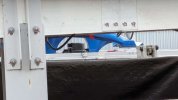There's anything but certainty that Intamin would have charted a fairer course. Understand there's an (unfortunate) laundry list of Intamin projects gone awry, especially at Cedar Point (Maverick barrel roll removal, Shoot the Rapids boat flip, MF and TTD lift cable snaps, etc.). Maybe it is, just hard, to do these high speed, high heights type of project?
That is, unless anyone wants to take the over on Falcon's Flight opening on time/facing no LSM glitch.

I must admit that this sort of thing makes me rather curious about Falcon's Flight.
Consider, for a moment, a rollercoaster as a system of components that have to work together for operation to be possible. Some components need to work flawlessly, others within tolerances, and yet others can technically fail without closing the coaster down, due to built-in redundancies. But for a lot of components, being out of tolerance means the coaster isn't operating until a fix can be carried out. A fault in any one of those components shuts down the ride.
Of course, the uptime of any given component can be very high. It's not unreasonable that the odds of any individual component working at any given time is something like 99.9%. But when you consider all the components that need to work together for the coaster to work, those odds have to be multiplied together.
In order for Falcon's Flight to operate, a whole bunch of components need to be working. There's a large and complex launch system (including a large and complex power supply), lots of brakes, a horde of sensors, miles of wiring, a central control system, several thousand meters of track, probably thousands of connection points between the track elements, the support structure, and the footers, and the trains are a whole interesting chapter by themselves. Such a large coaster has a
lot of things that can go wrong, and the speeds involved means narrow tolerances and enormous load factors. Consider just the wear on wheels, for instance, compared to a smaller Intamin like the Mega-Lites (which are only a third as fast and a sixth as long).
In other words, there are lots of little risk factors that need to be multiplied together, and even if we're working with individual odds close to 1, the total product grows smaller and smaller. Say there are 20 components with a reliability of 99.9%, that gives a total downtime of approximately 2%. But if the reliability of the components, due to high stress, is 99.5% instead? 10% downtime. If there are 30 components instead? 14% downtime. Or if there are only 10 components, but they only exhibit 95% reliability?
40% downtime.
It seems likely that TT2 might have stumbled into that trap. Too many things that can go wrong, too high odds of
something going wrong, and errors are expensive as heck to adrress. I've got a feeling that Intamin and Six Flags Qiddiya are going to get it so much worse. They are working against Murphy's Law here. They're building a coaster with a lot of things that can go wrong, and a relatively high likelihood of things going wrong. Subsequently, it must cost a fortune to maintain. I really don't see how they plan to recoup those costs by operating a theme park. TTD might have run at a loss for Cedar Point, TT2 might turn out even worse. Even that coaster seems to be skirting close to the limit of what is a reasonable level of operational risk for a park to manage. Falcon's Flight takes it to a whole new level. It will take enormous effort to make that thing run reliably - if that is at all possible. I really can't see it ever making its money back.

